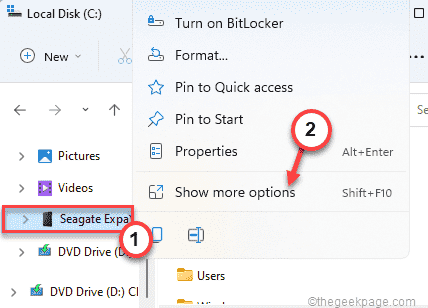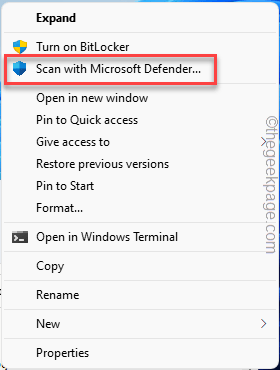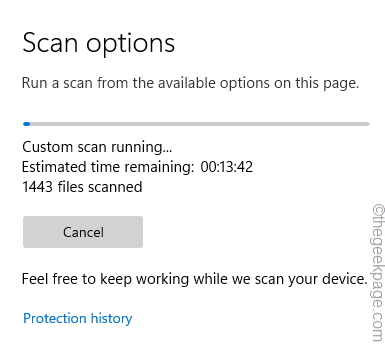When Windows can’t read an internal HDD or an external one, it shows up “There was a problem starting…” this error message on your screen. This error doesn’t usually happen when the system starts up, but it appears while you try to open the HDD/SSD from a shortcut from another HDD. Don’t panic if you see this error message. It can happen due to malware or PUP existing in the HDD.
Fix 1 – Run a full scan of the HDD
Running the full scan of your HDD should detect and quarantine the PUPs, malware from the system.
1. Open the File Explorer on your system.
2. Then, on the left-hand pane, you will notice the list of drives.
3. Now, right-click on the problematic HDD drive and tap on “Show more options” to access additional choices.

4. Then, tap on “Scan with Microsoft Defender…” to scan your hard disk with Windows Security.

Windows Security will open up and the scanning process will begin.

It will take a while until the scanning process is over. It will quarantine any foreign threats present on the drive. Now, try to access the drive using the shortcut again.
Fix 2 – Remove any PUP
If there are any PUP (Potentially Unwanted Program) installed due to malware or other elements, you will see this RunDLL error message.
1. At first, press the Windows key+R keys together.
2. Then, type “regedit” and hit Enter to access the Registry Editor.

Warning – A single wrong modification in the key can wreck your system irreversibly.
When the Registry Editor opens up, click on “File“. Then tap on “Export” to create a new registry backup on your system.

3. On the left-hand side, navigate this way ~
HKEY_CURRENT_USER\Software\Microsoft\Windows\CurrentVersion\Run
4. On the right-hand side, you will find some values associated with either Microsoft or a third party.
5. Carefully notice if you can find any suspicious entry here.

6. Then, just right-click on the suspicious PUP and then tap on “Delete“.

7. If you notice a prompt, tap on “Yes” to remove it from your computer.

8. Then, go to these registry locations and check if you can find any suspicious registry value.
If you can find one, remove it following the same steps we have discussed before.
HKEY_CURRENT_USER\Software\Microsoft\Windows\CurrentVersion\RunOnce HKEY_LOCAL_MACHINE\Software\Microsoft\Windows\CurrentVersion\Run HKEY_LOCAL_MACHINE\Software\Microsoft\Windows\CurrentVersion\RunOnce
Once you are done removing all the entries from the Registry Editor, close it and restart your computer.
After rebooting your device, try to access the hard disk drive once more.
Fix 3 – Remove the AutoRun.inf from the affected drive
AutoRun.inf file is used to automatically run AutoRun and AutoPlay components on a storage drive. If there are any corrupted AutoRun.inf file exists on the affected drive it can cause this issue.
Step 1
1. Open the File Explorer.
2. Then, tap on the “This PC“.
3. Here, you will find all the connected drives and devices. Note down the drive letter of the affected drive.
It is “E:” in our case.

Step 2
1. At first, press the Windows key and type “cmd“.
2. Then, right-click on the “Command Prompt” and tap on “Run as administrator“.

3. Now, you have to navigate to the affected drive using the CD command.
CD affected drive letter:
[ Just replace the “affected drive letter:” with the drive letter you are facing this trouble with.
Example – In our case, the drive letter is “E:“. So, the command will be-
CD E:
]

4. Now, copy-paste these two commands and hit Enter to remove the autorun.inf file.
Attrib -r -s -h e:\autorun.inf Del /F e:\autorun.inf
[As you can understand that the “f:” is the drive letter of the affected drive.
You can replace it with the drive letter of the affected system on your system.]

Once the process completes, close the Command Prompt terminal and restart the system at once.
Then try to access the HDD again. This time it will open normally.
Fix 4 – Run a disk scan
You have to run a disk checking operation to scan and repair the affected drive.
1. At first, press the Windows key+E keys together.
2. Go to the “This PC“.
3.. When the File Explorer window opens up, right-click on the affected drive and tap on “Properties“.

4. In the Properties window, go to the “Tools” tab.
5. Here, in the ‘Error checking’ portion, tap on “Check” to check the disk.

6. Now, tap on “Scan and repair drive” to let Windows scan and repair the affected drive automatically.

Allow Windows a little bit of time to fix the drive on your computer.
Fix 5 – Remove the BackgroundContainer task
The BackgroundContainer task can cause this issue in some of the cases. Deleting it should help you.
1. At first, press the Windows key+R keys together.
2. Then, type “taskschd.msc” and hit Enter.

3. Now, tap on the “Task Scheduler Library” on the left-hand side.
4. Then, on the right-hand side, right-click on the “BackgroundContainer” task and tap on “Delete” to remove it.

5. Again, tap on “Yes” to remove the task from your system.

After that, close the Task Scheduler on your computer. Then, perform a normal system reboot.
After rebooting, try to access the hard disk drive again. This time it will open up without any further issues.